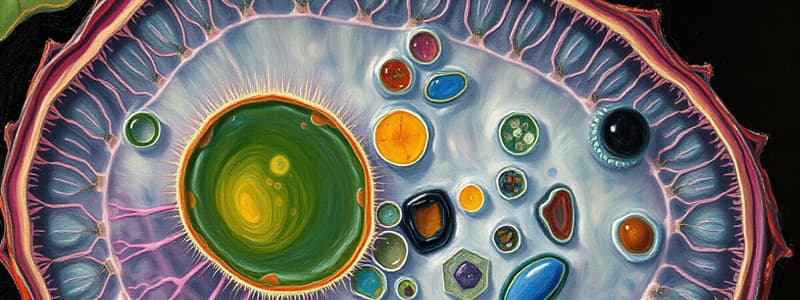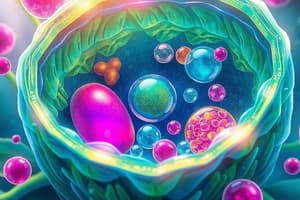Podcast
Questions and Answers
What is the cell wall?
What is the cell wall?
- The powerhouse of the cell
- A selective barrier controlling substance entry and exit
- An organelle involved in protein synthesis
- A rigid structure that surrounds the cell membrane and provides support to the plant cell (correct)
What is the function of the cell membrane?
What is the function of the cell membrane?
- Controls which substances can enter or leave the cell (correct)
- Packages proteins for distribution
- Site of ATP (energy) production
- Captures sunlight for photosynthesis
What is the function of the Golgi body?
What is the function of the Golgi body?
Receives proteins and materials from the endoplasmic reticulum, packages them, and distributes them.
What is the role of chloroplasts in a plant cell?
What is the role of chloroplasts in a plant cell?
What is the endoplasmic reticulum (ER)?
What is the endoplasmic reticulum (ER)?
What is the function of the vacuole?
What is the function of the vacuole?
What is the nucleus?
What is the nucleus?
What is the role of mitochondria?
What is the role of mitochondria?
What do ribosomes do?
What do ribosomes do?
Flashcards are hidden until you start studying
Study Notes
Plant Cell Structure
- Cell Wall: Rigid outer layer providing support and protection for the plant cell.
- Cell Membrane: Semi-permeable barrier that regulates the movement of substances in and out of the cell.
Organelles and Their Functions
- Golgi Body: Responsible for modifying, packaging, and distributing proteins and other materials received from the Endoplasmic Reticulum.
- Chloroplast: Site of photosynthesis, contains chlorophyll to capture sunlight and convert it into energy, exclusive to plant cells.
- Endoplasmic Reticulum (ER): Network of membranes forming passageways for transporting proteins and materials within the cell.
Storage and Energy
- Vacuole: Storage sac for nutrients, waste products, water, and other materials, significant in maintaining turgor pressure in plant cells.
- Nucleus: Control center of the cell; contains genetic material (DNA) that directs cellular activities.
- Mitochondrion: Known as the powerhouse of the cell; involved in the production of ATP, the energy currency of the cell.
Protein Synthesis
- Ribosomes: Small structures either attached to the ER or free-floating in the cytoplasm; vital for protein synthesis.
Studying That Suits You
Use AI to generate personalized quizzes and flashcards to suit your learning preferences.




